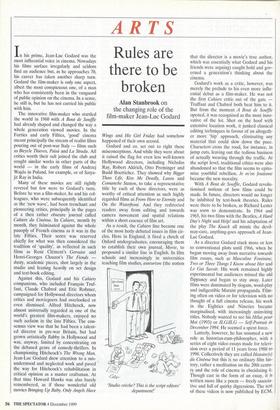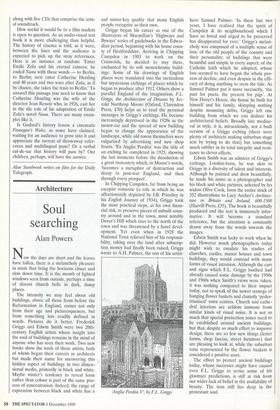ARTS
Rules are there to be broken
Alan Stanbrook on the changing role of the film-maker Jean-Luc Godard In his prime, Jean-Luc Godard was the most influential voice in cinema. Nowadays his films surface irregularly and seldom find an audience but, as he approaches 70, his career has taken another sharp turn. Godard the film-maker is only one aspect, albeit the most conspicuous one, of a man who has consistently been in the vanguard of public opinion on the cinema. In a sense, he still is, but he has not carried his public with him.
The innovative film-maker who startled the world in 1960 with A Bout de Souffle had already shaped and changed the way a whole generation viewed movies. In the Forties and early Fifties, 'good' cinema meant principally the stream of realist films pouring out of post-war Italy — films such as Bicycle Thieves, Pais() and La Strada. All critics worth their salt joined the club and sought similar works in other parts of the world — in the early films of Andrzej Wajda in Poland, for example, or of Satya- jit Ray in India.
Many of these movies are still rightly revered but few were to Godard's taste. Before he was a film-maker, he and his col- leagues, who were subsequently identified as the new wave', had been trenchant and pioneering critics, principally in the pages of a then rather obscure journal called Cahiers du Cinema. In Cahiers, month by month, they fulminated against the whole panoply of French cinema as it was in the late Fifties. Their scorn was reserved chiefly for what was then considered the tradition of 'quality', as reflected in such films as Rene Clement's Gervaise and Henri-Georges Clouzot's The Fiends dusty, academic pieces, shot largely in the studio and leaning heavily on set design and text-book editing.
Against this, Godard and his Cahiers companions, who included Francois Truf- faut, Claude Chabrol and Eric Rohmer, campaigned for Hollywood directors whom critics and moviegoers had overlooked or even dismissed. Alfred Hitchcock, now almost universally regarded as one of the world's greatest film-makers, enjoyed no such acclaim in the late Fifties. The con- sensus view was that he had been a talent- ed director in pre-war Britain, but had grown artistically flabby in Hollywood and was, anyway, limited by concentrating on the debased genre of comedy-thrillers. In championing Hitchcock's The Wrong Man, Jean-Luc Godard drew attention to a mis- understood and neglected work and paved the way for Hitchcock's rehabilitation in critical opinion as a master craftsman. At that time Howard Hawks was also barely remembered, as if those wonderful old movies Bringing Up Baby, Only Angels Have Wings and His Girl Friday had somehow happened of their own accord.
Godard and co. set out to right these misconceptions. And while they were about it raised the flag for even less well-known Hollywood directors, including Nicholas Ray, Robert Aldrich, Otto Preminger and Budd Boetticher. They showed why Bi,:er Than Life, Kiss Me Deadly, Laura and Comanche Station, to take a representative title by each of these directors, were as worthy of critical attention as such highly regarded films as From Here to Eternity and On the Waterfront. And they redirected readers away from editing and towards camera movement and spatial relations within a short essence of film art.
As a result, the Cahiers line became one of the most hotly debated issues in film cir- cles. Here in England, it fired a clutch of Oxford undergraduates, encouraging them to establish their own journal, Movie, to propound a similar line in English. In film schools and increasingly in universities teaching film studies, auteurism (the notion `Studio creche? This is the script editors' department!' that the director is a movie's true author, which was essentially what Godard and his friends were arguing) caught hold and gov- erned a generation's thinking about the cinema.
Godard's work as a critic, however, was merely the prelude to his even more influ- ential debut as a film-maker. He was not the first Cahiers critic out of the gate Truffaut and Chabrol both beat him to it. But from the moment A Bout de Souffle opened, it was recognised as the most inno- vative of the lot. Shot on the hoof with extensive location work, it junked classical editing techniques in favour of an altogeth- er more 'hip' approach, eliminating any material that could slow down the pace. Characters cross the road, for instance, in jump cuts, leaving out the tedious business of actually weaving through the traffic. At the script level, traditional ethics were also abandoned so that the film seems to epito- mise youthful rebellion. Je m'en foutisme became the new morality.
With A Bout de Souffle, Godard revolu- tionised notions of how films could be made. In future, directors would no longer be inhibited by text-book theories. Rules were there to be broken, as Richard Lester was soon to demonstrate. In 1964 and 1965, his two films with the Beatles, A Hard Day's Night and Help! and his adaptation of the play The Knack all mimic the devil- may-care, anything-goes approach of Jean- Luc Godard.
As a director Godard stuck more or less to conventional plots until 1966, when he began moving away from narrative towards film essays, such as Masculine Feminine, Two or Three Things I Know about Her and Le Gai Savoir. His work remained highly experimental but audiences missed the old flippancy and began to stay away. Later films were dominated by slogans, word-play and indigestible Marxist propaganda. Film- ing often on video or for television with no thought of a full cinema release, his work in the Eighties and Nineties became marginalised, with increasingly uninviting titles. Nobody wanted to see his Helas pour Moi (1993) or JLGIJLG — Self-Portrait in December 1994. He seemed a spent force.
Latterly, however, he has assumed a new role as historian-cum-philosopher, with a series of eight video essays made for televi- sion over a period of 11 years from 1988 to 1998. Collectively they are called Histoire(s) du Cinema but this is no ordinary film his- tory, rather a meditation on the 20th centu- ry and the role of cinema in elucidating it. Though cast in the form of an essay, it is written more like a poem -- freely associa- tive and full of quirky digressions. The text of these videos is now published by ECM, along with five CDs that comprise the actu- al soundtrack.
How useful it would be to a film student is open to question. As an audio-visual text book it is more challenging than helpful. The history of cinema is told, as it were, between the lines and the audience is expected to pick up the stray references. Here is an instance at random: 'Enter Emile Zola and his eternal camera; he ended Nana with these words — to Berlin, to Berlin; next enter Catherine Hessling and 40 years and two wars after Zola, as if by chance, she takes the train to Berlin.' To unravel this passage you need to know that Catherine Hessling was the wife of the director Jean Renoir who, in 1926, cast her in the tile role of his adaptation of Emile Zola's novel Nana. There are many exam- ples like it.
Is Godard's history lesson a cinematic Finnegan's Wake, as some have claimed, waiting for an audience to grow into it and appreciate the torrent of throwaway refer- ences and multilingual puns? Or a verbal cul-de-sac that history will pass by? Our children, perhaps, will have the answer.
Alan Stanbrook writes on film for the Daily Telegraph.



















































































 Previous page
Previous page